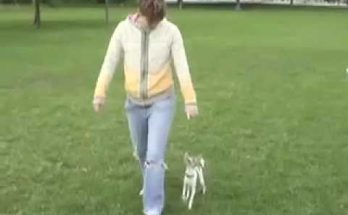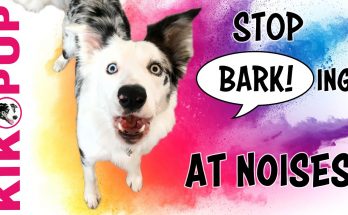This is the third episode in the series of Barking. In this episode I will show you the beginning exercises on how to teach your dog not to bark on a walk. Stay tuned and Subscribe to see other exercises that are very useful for reactive dogs and dogs that are hyperactive.
All these exercises benefit ANY dog, not just fearful, reactive or aroused dogs. These same exercises are GREAT for dogs with little impulse control, the kind of dog that wants to pull towards everything on a walk.
———————–
When a dog becomes aroused or reactive, it is due to chemicals being released by the brain, effecting the dogs behavior. Not only does a dogs behavior change because of these chemicals and stress hormones, but their heart beat, respiration, and blood flow will change too. Jerking a dogs neck will not reduce these chemicals, instead it will INCREASE them.
Barking can be reinforcing, so the more a dog is allowed to bark the more likely they will continue barking in the future. When you and your dog are surprised on a walk and your dog starts to bark, simply say "Let's Go" and move briskly in the opposite direction. You can use this cue whenever you change direction unexpectedly or need to move from an area that is causing your dog to be over their threshold.
Here are some tips:
1-when on a walk cross the street to set your dog up for success
2-If you have a very fearful or reactive dog, simply change the direction of your walk when you see something your dog wont be able to handle at this point in their training
3-Never feed the dog for looking at your treats
4-Use real meat or cheese for these exercises, the higher value the reinforcement the faster your dog will learn. If you use low level treats, your dog might not make any progress
5-You can use calming signals to help calm your dog on a walk. Yawning or sighing loudly when you see the distraction. You can also walk in an arc around the distraction rather than head on which is very unnatural for a dog to do.
6-If you are getting frustrated, better turn and go home immediately than take it out on the dog.
Dog training clicker training behavior modification how to train your dog not to bark how to stop your dog from barking at other dogs and people how to stop your dog from pulling loose leash walking how to get your dog to be calm and relaxed on a walk how to stop a husky from pulling huskie Canadian Husky dog training sled dog calming signals applied to training reactive aggressive dogs
#dogtraining #stopbarking #professionaldogtraining





Great video on reactivity. I love how you don’t just tell people but SHOW them. Timing is 95% of your success.
Do you have any exercises along the same line for fence fighting? I usually let Desperado out back w/ my sister’s golden when I’m at school and they are horrible fence fighters. The worst part is that now I can hardly use the back yard to play with him now because as soon as the other dogs come out he is gone.
Fabulous video! I think I’ll start the lunging-on-leash exercise with my dog this week!
Yes, I believe when these stressful events occur, we get stressed along with the dog, and find it difficult to control OUR reactions. The more we practice, the less likely we are to lose our cool under pressure. So, the training benefits both dog and human.
I hope to make more videos on this topic, I think people should have this info for free! So many dogs need it!
I completely agree. I’ve had times where I have to say, “OK, I’m getting a little frustrated, that’s enough for today.” I understood what you meant. Sometimes if I’m just anxious about unrelated things, I have to remind myself to take some deep breaths and relax while walking my dog.
1) Emily – funny enough, we just started doing this with Vela – she gets so excited when she sees other dogs. Just want to play, play play. Goal is to be able to pass another dog on the street.
2) When using Firefox, download the Firefox plug-in (add-on) called Download Helper. Available for either Mac or Windows. It installs next to the URL field. WOrks like a charm for just about all browser viewable video content.
Thanks for your great videos. YOU ROCK!!!
I have just come across your video page, home page and blog, and I will follow them closely from now on. I was a bit stuck in teaching my dog pivoting, and I also wanted to find some new tricks to train, and when I came across your video page, I got all the help I needed, and SO much more! Now I have watched lots of your videos and set up a training plan for passing dogs, for barking at strange people, and of course for pivoting and tricks 🙂 Thank you so much for sharing!
Thanks! Your videos are great! I have done a lot of clicker training with horses but am new to dogs and your videos are a fantastic help!
Emily, my dog has gotten so reactive to cats and squirrels in the back yard that he is injuring himself by jumping against the fence. He’s better when on a walk but I hope that–by using your methods–I can change his behavior in the yard. Before he gets badly hurt.
Excellent video. But I have been using these techniques for over a year with our dog reactive/aggressive English Springer Spaniel. His reactivity is unpredictable, about 75% of encounters. He lunges and barks/yips at many approaching or fenced in dogs. We had great improvement, and then one day at a park, another distant dog began staring and barking at him, and he is now wildly reactive again. He’s highly food motivated, but ignores treats at these times, or gobbles them but keeps barking. Help
I have a big strong excitable Weimarraner X who has been difficult to teach to heel & also barking at people on a walk. After trying loads of positive methods, without much success, I tried this tonight and it worked like magic.Within five minutes, she was walking to heel beautifully & she loved the ‘let’s go!!’ Early days, but this has been her best response so far. Thank you 🙂
Actually, turning around will help your dog succeed in training. When you walk in the other direction, you’re communicating with them that you want them to focus on something else. it is like telling them to change the subject and move on. hope this helps!
Remember also to work with your dog with a Let’s Go, LOTS on walks, (everyday) so your dog doesn’t stop and wait to see what “trigger” he is leaving before deciding to leave. If this has been well trained he will immediately follow you when you say Let’s Go, without looking for the “trigger”.
Thanks for breaking this down into easy to do steps I’ll practice this in spring. We’re doing 1 & 2 constantly. It’s really difficult to train a dog in the suburbs where few people walk their dogs (especially in the cold months). I thought socializing a dog would be so easy with daily walks, but so many people did 1 & 2 that my dog didn’t get enough interactions.
These tips have worked wonders for us. We implement them all and actually enjoy running into situations to challenge us now. Thank you Emily for the best dog training tips! And we use this with squirrels on our walk too:)
Great video.I’ll practice with my dog starting tomorrow.I have a 4 years old American Staffordshire Terrier who’s an angel but got bitten last summer and since then he became fearfull and sometimes barks back when other dogs piss him off.He’s strong, very strong and if the other dog doesn’t stop threatening him or I don’t switch direction fast enough he could end up with the other in 10 seconds.Until now I’ve tried to avoid encounters with them cause I didn’t know what to do, but not anymore 🙂
A couple of these comments completely overlook the point of clicker training. I adopted a poorly behaved high-energy 9month old lab cross. Two months later and lots of reruns of kikopup vids, she’s like a new animal. I don’t know the dog trainer in these videos – I’m just a random viewer from Toronto with a really good dog now! One thing: You need to have a food motivated dog for great success with this. My other dog isn’t so food motivated but she now likes the clicker sound and knows it means she is good. And over time, you slowly stop using the clicker/treat. I still click with my mouth when they need reinforcement. And yeah, I always have kibble or treats in my pockets. I used to wear nice clothes, lol.
Great stuff, I love how you work with all kinds of dogs, it reminds others how this positive training is rather simple and works, but needs to be consistent.I also found just sitting in a place being boring that is reactive, just not overly triggering, then just trying to train after a while the dog will stop or slow down the reactivity and eventually you can treat and train. It takes a lot of dedication and the outing has to be for just that training and done regularly until the pup gets what you want. I found this to work with new things too for both dogs and kids. The trick is to be physically, mentally and spiritually prepared for it before you go and to know how much you and your dog can handle in one shot each time. Keep sharing I have learned so much from these videos. Blessings..
New article: Solving barking at noises outside of your house or apartment : https://dogmantics.com/solving-barking-at-noises/
“If you’re getting frustrated with your dog better to just go home.” I totally agree…when I was training my dog in the beginning he was totally out of control and looking back I wish I would have simply turned back and went home. Instead I’d push through but with immense frustration that I know he could sense and it only slowed us down in the long run.